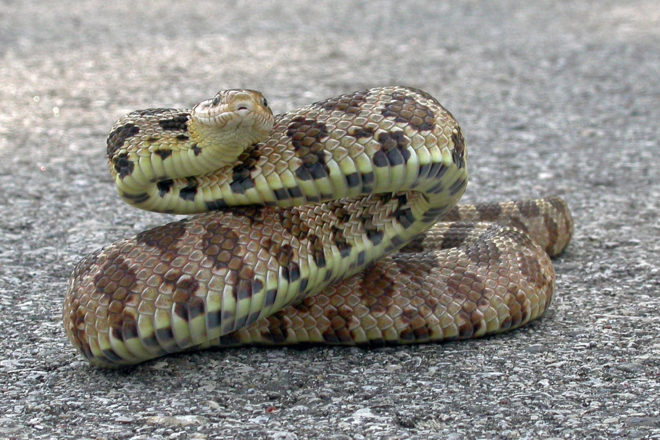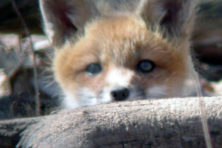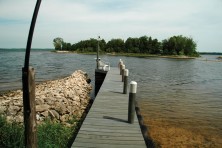Door to Nature: The Fox Snake
- Share
- Tweet
- Pin
- Share

Suppose you owned a farm and someone informed you that an animal, native to all but the extreme northwestern tip of Wisconsin was benefiting you annually to the sum of at least $100 or more. Wouldn’t this come as good news and wouldn’t you do all in your power to encourage the success and increase of these creatures?
Or imagine yourself renting a beautiful rustic cottage and the owner tells you not to worry about rats or mice because another harmless animal was doing a perfect job of controlling those pests free of charge with no pet food to buy. This would surely come as good news.
Suddenly out of the lush green grass glides a fox snake, sometimes called the pine snake, and pandemonium breaks loose. Someone grabs the nearest stick while another races for a shovel. Within seconds the snake is dead and everyone breathes great sighs of relief. And if rejoicing takes place within the ranks of the lower animals, the rats and mice would be dancing in the tunnels. Their number one enemy had been slain!

A view from the top shows the fox snake’s leathery tan head color.
Granted it takes more than reading or being told that snakes are beneficial animals and that it is not a simple matter to tolerate them with ease in your backyard. Perhaps it’s their quietness, nearness to the ground, their fine camouflage and the fact that they nearly always catch you off guard that inevitably leads them to scare the wits out of most people. The fact remains that people in general dislike snakes and, of all native snakes, especially resent the useful rodent eater, the fox snake, perhaps the most maligned animal of all in this region.
Several years ago a lady called and asked, “Do copperhead snakes live in Door County?” My answer was, “No Ma’am, they don’t.” Before I could get another word in edgewise she snapped back at me, “Oh yeah, well I sure do have a huge one here right at my place!” She was obviously as convinced that it was a copperhead as I was absolutely positive, being a stubborn Czech, that it was a fox snake.
Perhaps my voice carried with it a bit of disbelief as I replied, “Bring it over and I’ll take a look at it.” Her receiver slammed down bringing me to my senses. How in the world would that woman, if she was as frightened as she sounded, ever get hold of a big fox snake?
Moments later a dusty pickup truck turned into my driveway and out bounded a very determined lady. The tailgate was already down as she reached in with an old broom handle and picked up the snake, deader than a doornail, and marched triumphantly, but shaking like a leaf, to my back door.
Every marking on the poor creature fit perfectly the description of the western fox snake. Its light leathery tan head had appeared coppery to her. Now it was my unpleasant task to inform her that she had killed the best “mouser” she could ever have had around her buildings.
The other day Charlotte and I were returning home from an unsuccessful attempt to photograph a den of young red foxes when what should we discover but a huge 50-inch fox snake warming itself in the middle of the black-topped road. I always stop to coax snakes off the road so they won’t be killed by cars. This one was reluctant to leave. Anyway, there was little or no traffic and there was plenty of room for cars to go around us. Here was the perfect chance for me to get a few close-ups of this fine adult reptile.
I got down onto my belly and inched toward the huge inquisitive creature, finally approaching to within 15 inches of its staring eye and motionless body. Naturally my wife took pictures of me photographing the beautiful animal. Suddenly the snake sensed it was being cornered and slithered with great haste into the brushy ditch. Both of us were quite amazed at its rapid retreat.
Its body shape interested me considerably as I watched it from close range. Imagine an inverted capital letter “U” with a straight line drawn across the open bottom. This would be a close approximation of its cross-sectional shape as compared to the much rounder shape of, for example, a garter snake.
The dark spots and blotches of this “friend to man” vary from brown to black. Its so-called ground color, or under color, is yellowish to light tan. The belly is also a dull yellow checkered with black. Above all, don’t expect to look at a picture in a snake book and see the exact image of the fox snake in your yard. Snakes can differ. Variation is the normal pattern in nature. Their colored patterns are not as though they were run off on a printing press.
Snakes native to northeastern Wisconsin do not possess front fangs and do not produce venom dangerous to humans. They will not chase after you and try to bite you. At best a few will assume a strike pose when cornered and make repeated lunges at you or whatever is brought close to their heads. Fox snakes, along with all other rat snakes, can vibrate their tail tips rapidly when alarmed. If the tail happens to strike dry grass or twigs one can easily be led to believe it is the sound of a rattlesnake.
Learn to know the fox snake as well as other members of this important group of reptiles. Welcome it to your property. It will stay out of your way, never attack you, and will keep your premises free of rodents for no cost.
Even though it may frighten you occasionally, respect the fox snake for its important role on Earth. Become “partners in nature” with all wild creatures.



